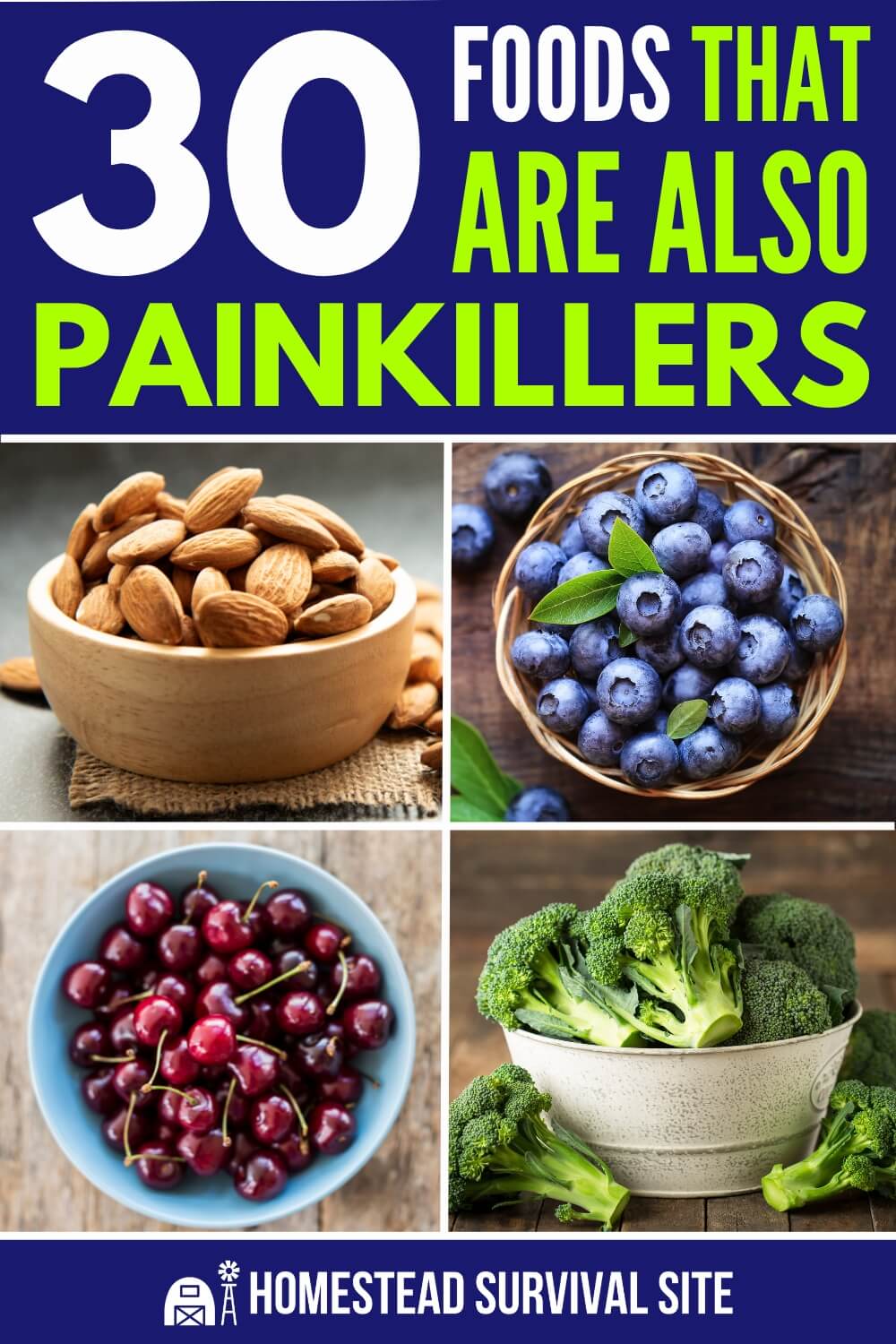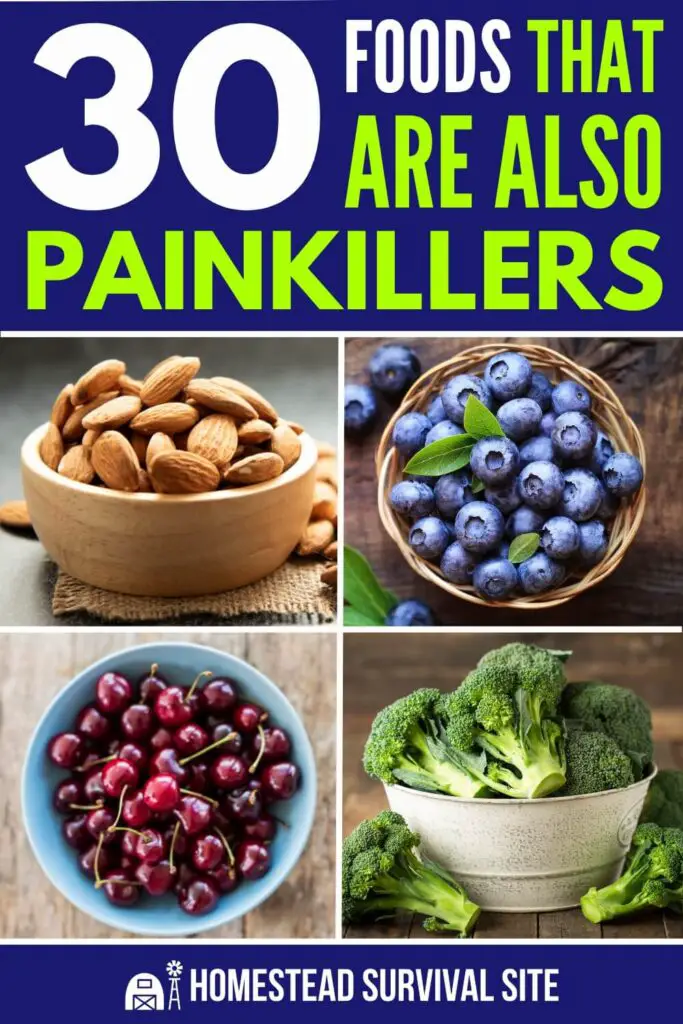Estimated reading time: 11 minutes
Most people don’t know it, but nature has provided us with an incredibly pharmacy of painkillers hidden in the foods we eat. Some of the most powerful remedies for pain aren’t found in pill bottles but in fruits, vegetables, herbs, and other natural ingredients.
These foods work in two ways: Some of them help with overall health and reduce chronic pain by lowering inflammation and supporting the bodies healing process, while others can act as quick, natural remedies for temporary pain.
If you want to minimize the pain in your life, whether it’s from a persistent condition or an occasional flare-up, a diet rich in the foods listed below is a great place to start. By adding these pain-relieving foods to your meals, you’ll boost your body’s resilience and soothe discomfort before it strikes.
In this article, we’ll not only share which foods are the most help for pain but also explain why they’re so effective and how to prepare them for temporary pain relief when needed. So without further ado, here are 30 foods that are also painkillers.
Want to save this post for later? Click Here to Pin It On Pinterest!
Almonds
Type of Pain: Muscle tension, headaches, and menstrual cramps.
Why It Works: Almond are packed with magnesium, a mineral that is essential for nerve function and muscle relaxation. If you don’t have enough magnesium in your diet, you may have an increased sensitivity to pain, especially headaches and muscle cramps.
Preparation and Use: Almond make a great snack. Just snack on them between meals, or consider using almost butter and almond flour when cooking.
Blueberries
Type of Pain: Muscle soreness, arthritis, and inflammation-related pain.
Why It Works: Blueberries are loaded with anthocyanins and other antioxidants that combat oxidative stress and inflammation, which is one of the main causes of chronic pain. Studies have shown that eating blueberries can reduce inflammation and help with arthritis and post-exercise soreness.
Preparation and Use: You can just snack on them, but I prefer mixing them into oatmeal, yogurt, and smoothies.
Broccoli
Type of Pain: Joint pain and inflammation.
Why It Works: Broccoli contains sulforaphane, a sulfur compound that reduces inflammation and protects joint cartilage from damage. It also helps the body produce anti-inflammatory enzymes, making it a great food for people with arthritis.
Preparation and Use: Broccoli is great raw, cooked, steamed, or grilled. Pair with olive oil, garlic, and lemon juice for a pain-fighting side dish.
Bone Broth
Type of Pain: Joint pain, post-surgery discomfort, and injuries.
Why It Works: Bone broth is rich in collagen, glucosamine, and chondroitin, all of which support joint health and help repair cartilage. These nutrients reduce stiffness and improve joint mobility over time. Bone broth also contains amino acids like glycine, which have anti-inflammatory effects.
Preparation and Use: Simmer bones (beef, chicken, or fish) with water, vegetables, and herbs for 12–24 hours to extract nutrients. Drink the broth warm on its own, or use it as a base for soups and stews.
Cayenne Pepper
Type of Pain: Neuropathy, arthritis, and muscle pain.
Why It Works: Capsaicin, the active compound in cayenne pepper, binds to pain receptors and desensitizes them, reducing the perception of pain over time. It also improves blood flow, which helps with muscle recovery and reduces stiffness.
Preparation and Use: For internal pain, add a pinch of cayenne pepper to soups, stews. For topical pain relief, mix cayenne powder with coconut oil to create a homemade salve and apply it to sore areas (but be cautious if you have sensitive skin).
Cherries
Type of Pain: Gout, arthritis, and exercise-induced soreness.
Why It Works: Tart cherries contain anthocyanins and polyphenols, which inhibit inflammatory pathways and reduce uric acid levels, making them effective for gout and arthritis. They also reduce oxidative stress in muscles after intense exercise.
Preparation and Use: For the best results, drink tart cherry juice every day. You can also snack on fresh or dried cherries. Or you could combine them with yogurt or oatmeal for an anti-inflammatory breakfast.
Chia Seeds
Type of Pain: Joint pain, chronic inflammation, and muscle recovery.
Why It Works: Chia seeds are one of the best sources of omega-3 fatty acids, which reduce inflammation and lubricate joints. They also contain antioxidants and fiber, which improve gut health and reduce systemic inflammation.
Preparation and Use: Soak chia seeds in water or almond milk for 15–20 minutes to make a pudding. You can also sprinkle them on salads, yogurt, cereal, and any other food you like.
Coconut Oil
Type of Pain: Skin irritation, joint pain, and inflammation.
Why It Works: Coconut oil is rich in medium-chain fatty acids, particularly lauric acid, which has anti-inflammatory and antimicrobial properties. It soothes irritated skin and reduces joint pain when applied topically.
Preparation and Use: When making any recipe that calls for fat or oil, simply use coconut oil instead. You can also massage it directly onto sore joints or irritated skin.
Dark Chocolate
Type of Pain: Stress-induced headaches, muscle tension, and general fatigue.
Why It Works: Dark chocolate contains flavonoids that improve blood flow and reduce inflammation. It also boosts serotonin and endorphin levels, which can naturally ease pain and improve your mood.
Preparation and Use: Be sure to eat chocolate with at least 70% cocoa. A piece or two every day will boost your health and reduce your pain over time.
Flaxseed Oil
Type of Pain: Joint stiffness and inflammatory conditions.
Why It Works: Flaxseed oil is rich in alpha-linolenic acid (ALA), a type of omega-3 fatty acid that reduces inflammation in joints and soft tissues. Eating it on a regular basis will improve mobility and reduce stiffness in people with arthritis.
Preparation and Use: Drizzle flaxseed oil over salads or mix it into smoothies. However, you shouldn’t cook with flaxseed oil as the heat will destroy its beneficial properties.
Garlic
Type of Pain: Arthritis, infections, and toothaches.
Why It Works: Garlic contains sulfur compounds like allicin, which have anti-inflammatory and antibacterial effects. These compounds reduce swelling in joints and fight infections that cause pain.
Preparation and Use: Add raw or cooked garlic to your meals every day. For toothaches, crush a garlic clove, mix it with a little salt, and apply it to the affected area for temporary relief.
Ginger
Type of Pain: Muscle soreness, migraines, and joint pain.
Why It Works: Gingerol, the active compound in ginger, inhibits inflammatory pathways and reduces muscle pain after exercise. Studies have also shown ginger’s effectiveness in alleviating migraines and arthritis pain.
Preparation and Use: Brew fresh ginger slices in hot water to make tea. You can also grate ginger into stir-fries, soups, smoothies, and other foods.
Honey
Type of Pain: Sore throat, burns, and minor wounds.
Why It Works: Honey has antimicrobial and anti-inflammatory properties that soothe irritation and promote healing. Its thick texture forms a protective barrier on wounds and burns.
Preparation and Use: Mix honey with warm water and lemon for a soothing drink, or apply it directly to burns and cuts. Be sure to use raw, unprocessed honey.
Kimchi
Type of Pain: Chronic inflammation and pain associated with autoimmune conditions.
Why It Works: Kimchi is a fermented food rich in probiotics, which help restore balance in the gut microbiome. A healthy gut reduces systemic inflammation, which can alleviate chronic pain, especially in conditions like arthritis and irritable bowel syndrome (IBS).
Preparation and Use: Eat kimchi as a side dish, add it to rice bowls, or use it as a topping for soups and salads. If you’re not used to fermented foods, start with a small amount.
Mushrooms
Type of Pain: Joint pain, chronic inflammation, and immune-related discomfort.
Why It Works: Mushrooms like shiitake and maitake contain polysaccharides and ergothioneine, which reduce inflammation and boost the immune system. These compounds are especially effective for relieving joint pain.
Preparation and Use: Sauté mushrooms in olive oil, add them to soups, or use them as a meat substitute in dishes like stir-fries or stews.
Oats
Type of Pain: Digestive discomfort, muscle soreness, and chronic inflammation.
Why It Works: Oats are a great source of beta-glucan, a type of soluble fiber that reduces gut inflammation. Oats can also stabilize blood sugar levels, which can indirectly reduce pain from inflammation.
Preparation and Use: Cook oats with water or milk for a warm, comforting meal. Be sure to add anti-inflammatory toppings like blueberries, chia seeds, and honey.
Olive Oil
Type of Pain: Arthritis, muscle pain, and general inflammation.
Why It Works: Extra virgin olive oil contains oleocanthal, a compound with effects similar to ibuprofen. It inhibits enzymes involved in inflammation, reducing pain and swelling in conditions like arthritis.
Preparation and Use: Use olive oil as a salad dressing or drizzle it over cooked vegetables. However, be careful not to overheat it as that can make it less effective.
Oranges
Type of Pain: Injury-related pain and pain caused by oxidative stress.
Why It Works: Oranges are rich in vitamin C, which is essential for collagen production and tissue repair. Vitamin C also acts as an antioxidant, reducing inflammation and promoting recovery after injuries.
Preparation and Use: Eat oranges as a snack, drink freshly squeezed juice, or use orange zest to flavor dishes.
Papaya
Type of Pain: Swelling, post-surgery pain, and injury-related inflammation.
Why It Works: Papaya contains papain, an enzyme that reduces swelling and inflammation, speeding up recovery after injuries.
Preparation and Use: Eat fresh papaya as a snack, or blend it into a smoothie with ginger for an extra anti-inflammatory boost.
Peppermint
Type of Pain: Headaches, muscle tension, and digestive pain.
Why It Works: Menthol, the active compound in peppermint, has a cooling effect that relaxes muscles and relieves tension. Peppermint also soothes the digestive system, making it great for cramps and bloating.
Preparation and Use: Brew peppermint leaves into tea, or apply diluted peppermint oil to your temples and neck for headache relief. You can also inhale peppermint steam to ease tension headaches.
Pineapple
Type of Pain: Swelling, post-surgery pain, and muscle soreness.
Why It Works: Pineapple contains bromelain, a powerful enzyme that reduces swelling and inflammation. It’s particularly useful for recovery from surgery or strenuous physical activity.
Preparation and Use: Eat fresh pineapple slices or drink freshly pressed pineapple juice. Avoid canned pineapple, as the processing can destroy bromelain.
Rosemary
Type of Pain: Muscle pain, joint stiffness, and headaches.
Why It Works: Rosemary contains rosmarinic acid, a compound that improves circulation and reduces inflammation. It also has mild analgesic properties, making it good for sore muscles and headaches.
Preparation and Use: Brew rosemary tea by steeping fresh or dried rosemary leaves in hot water. You can also infuse olive oil with rosemary and massage it onto sore areas.
Salmon
Type of Pain: Joint pain, stiffness, and chronic inflammation.
Why It Works: Salmon is rich in omega-3 fatty acids, which are potent anti-inflammatory agents. These fats reduce the production of inflammatory molecules, easing joint.
Preparation and Use: Bake, grill, or poach salmon for a nutritious meal. Pair it with leafy greens and olive oil for even more anti-inflammatory benefits.
Spinach
Type of Pain: Muscle cramps, migraines, and chronic inflammation.
Why It Works: Spinach is packed with magnesium and potassium, two minerals that relax muscles and improve circulation. It also contains antioxidants like lutein and zeaxanthin, which reduce inflammation.
Preparation and Use: Sauté spinach with garlic and olive oil, or blend it into a smoothie with almond milk and chia seeds.
Sweet Potatoes
Type of Pain: Chronic inflammation, injury recovery, and immune-related discomfort.
Why It Works: Sweet potatoes are high in beta-carotene, vitamin C, and magnesium, which promote healing and reduce inflammation. They also support the immune system.
Preparation and Use: Roast sweet potatoes with a drizzle of olive oil, or mash them with cinnamon for a comforting, anti-inflammatory side dish.
Thyme
Type of Pain: Respiratory pain, sore throat, and minor muscle pain.
Why It Works: Thyme has antimicrobial and anti-inflammatory properties that soothe respiratory discomfort and fight infections. It also contains thymol, which is a natural muscle relaxant.
Preparation and Use: Brew thyme tea by steeping fresh leaves in hot water and adding a little honey. This tea is great for throat pain. Thyme is also great for seasoning soups, stews, and roasted vegetables.
Turmeric
Type of Pain: Arthritis, muscle pain, and chronic inflammation.
Why It Works: Turmeric contains curcumin, one of the most potent natural anti-inflammatory compounds. It inhibits enzymes and molecules responsible for inflammation, making it great for joint pain and other chronic conditions.
Preparation and Use: Add turmeric to curries, soups, or rice dishes. You can also make “golden milk” by mixing turmeric with warm milk and honey.
Walnuts
Type of Pain: Joint pain, arthritis, and muscle soreness.
Why It Works: Walnuts are an excellent source of omega-3 fatty acids, which reduce inflammation in joints and tissues. They also provide magnesium, which helps with muscle relaxation.
Preparation and Use: Snack on a handful of walnuts every day, or chop them up and sprinkle them on salads, yogurt, or oatmeal.
Watermelon
Type of Pain: Muscle soreness and heat-related discomfort.
Why It Works: Watermelon contains citrulline, an amino acid that improves blood flow and reduces muscle soreness after exercise.
Preparation and Use: Eat fresh watermelon slices, or blend it into a smoothie with mint and lime.
Yogurt
Type of Pain: Digestive pain, gut inflammation, and systemic inflammation.
Why It Works: Yogurt is rich in probiotics, which restore healthy gut bacteria. A balanced gut microbiome reduces inflammation throughout the body and soothes digestive problems.
Preparation and Use: Choose plain, unsweetened yogurt for maximum benefits. Top it with blueberries, chia seeds, and honey for an anti-inflammatory snack.
Final Thoughts
If you avoid processed foods and add more of the foods above into your diet, you’ll improve your health reduce your risk of chronic pain. And if a healthier diet doesn’t make the pain go away completely, it will at least make the pain less intense.
In addition, you’ll experience many other benefits including more energy, mental clarity, fewer health problems, and faster healing and recovery times. These foods are in nature for a reason. Enjoy them!
Like this post? Don't Forget to Pin It On Pinterest!
You May Also Like:













